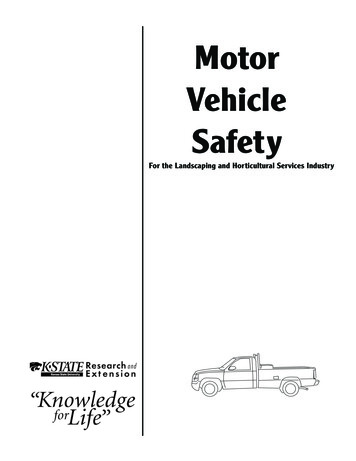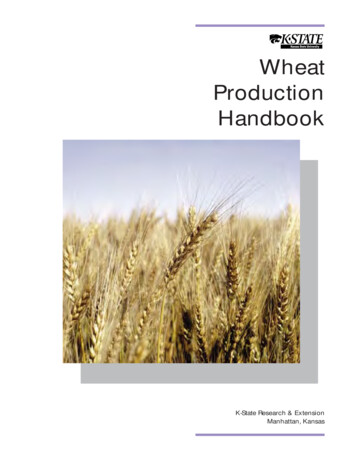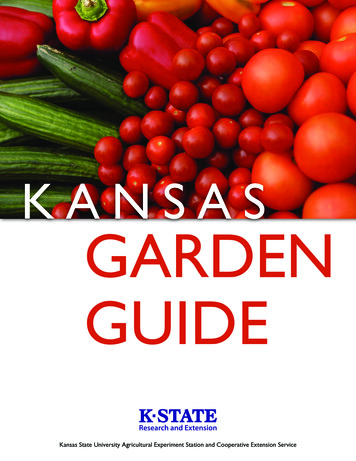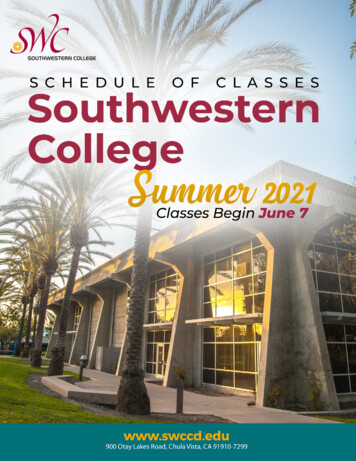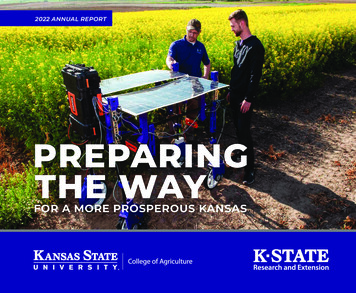
Transcription
2022 ANNUAL REPORTPREPARINGTHE WAYFOR A MORE PROSPEROUS KANSAS
BUILDING A STATE OF POSSIBILITYIn 2021, Kansas State University laid the groundwork to bring greater prosperityand a better quality of life to people living in Kansas.The year before, the Kansas Board of Regents (KBOR) asked all state-supportedcolleges and universities to submit proposals to identify how they can do moreto increase economic activity in the state. KBOR selected K-State’s EconomicProsperity Plan, which identified four focus areas where we have existing,differentiating strengths, and the work coming from those areas have thepotential to spark economic growth.2 College of Agriculture and K-State Research and Extension
Focus area one:Food & AgricultureSystems InnovationKansas has been a leader in the production of food and feed crops, beefand dairy products for more than a century. K-State’s prosperity planwill capitalize on this to attract more ag manufacturing in Kansas. Forexample, rather than sending our unique wheat and sorghum varietiesout of state as commodities, we keep more in state to make snack bars,consumption alcohol or other products here in Kansas. We can keepmore of the beef processing and packaging in Kansas and use milk toproduce cheese and yogurt within the state.K-State partners with producers to create new products, which will lead to new jobs and increased economic activity.2022 Annual Report 3
Focus area two:Digital Agriculture &Advanced AnalyticsThis focus area will develop and use new technologies to mine andanalyze vast amounts of data to help farmers know precisely whenand where to apply water, fertilizer, pesticides and other inputs. Thisinnovation will take the complexity out of making these critical decisionsby offering farmers a simple, precise and automated system that willprovide the information they need to increase their food productionwhile decreasing their natural resources footprint.Data generation and digital solutions are the answer for greater yields and efficiencies.4 College of Agriculture and K-State Research and Extension
Focus area three:Biosecurity &BiodefenseK-State is the only university in the world with access to a fullcontinuum of biosecurity laboratories located on or adjacent to campus.K-State will bring corporate partners to Kansas to take advantageof these unique facilities to develop diagnostic, therapeutic andpreventive countermeasures for a broad range of emerging zoonoticdiseases. The College of Agriculture will also provide plant diseasediagnostics, research, surveillance and training in disease vector biology.The laboratories will offer emergency rapid testing and manufacturingto protect the nation’s animal health and food supply during a crisis.The National Bio and Agro-Defense Facility (left) is located within the Kansas City Animal Health Corridor.NBAF campus photo courtesy of USDA NBAF Communications2022 Annual Report 5
Focus area four:K-State 105K-State 105 maximizes K-State Research and Extension’s presence inall 105 counties to drive economic prosperity in the state. Throughthis initiative, businesses and communities will have greater accessto K-State innovation, talent and training through local agents andcoordinated resources. Extension’s research centers, experiment fieldsand highly skilled scientists and staff, combined with the climateand soil variability across the state, provide unique opportunities foragricultural research and corporate and private partnerships.K-State Research and Extension has consistently worked to improve lives, livelihoods and communities. With this plan, we can furtherstreamline methods for businesses and communities across Kansas to access our innovation, talent and training.6 College of Agriculture and K-State Research and Extension
Sustainable agriculture – a priority that cuts across allfocus areasAgricultural sustainability is based on the principle that we must meet the needs ofthe present without compromising the health and well-being of future generations.Long-term prosperity requires long-term stewardship of natural resources andensures social and economic equity for all.In addition, this cross-cutting theme will focus on resiliency and adaptation todevelop solutions and implement action to respond to the impacts of climatechange that are already happening and prepare for future impacts.Each focus area will support a healthy environment, economic profitability, and social and economic equity.2022 Annual Report 7
Preparing the path for greater economic prosperityThe Economic Prosperity Plan focuses heavily on the strengths of the College ofAgriculture and K-State Research and Extension. Our success in providing the besteducation, research and outreach has laid the groundwork for a new and strongereconomy for Kansas.8 College of Agriculture and K-State Research and Extension
EXCELLENCE IN EDUCATIONPreparing tomorrow’s agricultural workforce, leaders and entrepreneursThe College of Ag ranksK-StateNO. 7RANKS 1STamong the nation’stop 144 ag schoolsin six of sevencategories Nichecompares:Niche.com, 20221.2.3.4.5.6.Cornell UniversityTexas A&M UniversityUniversity of GeorgiaUniversity of FloridaUniversity of California – DavisNorth Carolina State University7. Kansas State University8.9.10.11.Oklahoma State UniversityClemson UniversityUniversity of WisconsinThe Ohio State University Professors put a lot of effortinto teaching. Professors care about theirstudents’ success. Professors are engaging andeasy to understand. Professors are approachableand helpful when needed. Students find it's easy to getinto the classes they want. Students say their workload iseasy to manage.K-State ranks in the top 10 despite our size. Our number of undergraduates is approximately half the averagenumber of undergraduates attending the other 10 schools.2022 Annual Report 9
College of Agriculture graduates are in demandA College of Agriculture degree from K-State is valued. More than 96%of our new graduates are employed or furthering their education.DEGREES 5UNDERGRAD20162017MASTER’S20182019Ph.D.10 College of Agriculture and K-State Research and Extension2020
From access to successNowhere is the College of Agriculture’s focus on student success more apparentthan when comparing salaries of new graduates by their ACT scores. Afterearning an ag degree at K-State, there is no statistical difference in the salaryof new agricultural graduates based on test scores.SALARY,USDSalary, 30ACTACTSCOREEach dot represents a student, and its placement represents his or her ACT score and starting salary.2022 Annual Report 1135
EXCELLENCE IN RESEARCHResearch awards have more than doubled between 2011 and 2021. The return oninvestment for research spending has been tremendous. Every 1 spent on research at thecollege and K-State Research and Extension returns 17 to the state's economy.Extramural awardsDOLLARS IN MILLIONS 70 65,339,797 58,241,282 60 56,182,850 57,319,138 45,285,286 50 40 50,236,346 48,672,298 38,454,478 36,537,015 43,316,801 30 20 23,830,745 10 020112012201320142015201620172018AWARD DOLLARS12 College of Agriculture and K-State Research and Extension201920202021
Research expendituresThe College of Agriculture and K-State Research and Extension have had annual research expenditures ofmore than 100 million since 2014. Research expenditures are the funds spent to conduct research andare the most frequently cited numbers for comparing research levels among colleges and universities.52.41%52.07%53.99%55.31%55.76%DOLLARS IN MILLIONS 200 16954.38%48.22%49.18% 219 21849.11% 214 196 193 189 185 183 17653.58% 150 100 89 92 99 102 105 104 107 105 108 105 50 02012UNIVERSITY TOTAL20142016AGRICULTURAL TOTAL2022 Annual Report 1320182020AG % OF UNIVERSITY TOTAL
EXCELLENCE IN EXTENSION2021 educational contactsK-State Research and Extension records the number ofdirect and indirect educational contacts made throughextension programming efforts across the state. A directeducational contact is defined as a face-to-face or one-onone interaction. An indirect educational contact is recordedwhen a programming effort or resource is distributedthrough radio, social media, email, etc.Direct educationalcontacts reported:708,792Indirect educationalcontacts reported:1,672,440Direct educational contactsby Grand ChallengeGlobal Food Systems – 114,639Health – 108,645Water and Natural Resources – 53,847Developing Tomorrow’s Leaders – 180,911Community Vitality – 97,454153,296volunteer educationalcontacts were madeVolunteer contacts are not asked tospecify a Grand Challenge14 College of Agriculture and K-State Research and Extension
University-developed software selected as national reportingsystem for SNAP-EdRecognizing a need for more stringent evaluation efforts, K-State Research and Extensionpartnered with the Office of Educational Innovation and Evaluation to develop theProgram Evaluation and Reporting System, or PEARS, a web-based system that wouldprovide a better way to track extension programming performance.Today, PEARS is used for national data collection for USDA’s SNAP-Ed program and statelevel extension reporting.States using PEARS data managementSNAP-ED ReportingExtension & SNAP-ED ReportingExtension Reporting2022 Annual Report 15
Restructuring to provide better serviceto the stateeastern regions, respectively. From serving as extensionagents to local unit extension directors, they are moreprepared to handle and understand local unit issues in theirregions.To provide better service and more specialized leadership forresearch centers and county offices across the state, K-StateResearch and Extension underwent a regional restructuringthat led to more effective management of local units andregional research center issues.In terms of extension research center management, DanDevlin, Ph.D., was promoted to oversee western researchand extension centers, and Bob Weaber, Ph.D., waspromoted to manage eastern centers. Their extension,research and leadership experience has prepared them tolead cutting-edge research at regional centers.From a local unit management perspective, the restructuringsplit the state into three regions - western, central andeastern. Mary Sullivan, Aliesa Woods and Carla Nemecekwere named regional directors for the western, central ScottEllsworthBartonRushKearnyFinneyWest no21 CentralKiowaDickinsonGearyJacksonWabaunseeFlint alnut layJeffersonRussellEllisGolden ellOsborneSunflowerRiver ValleyPost RockPhillipsRooksLeavenworthTwin SedgwickNeoshoWilsonKingmanKansas State ComancheBarberHarperSumnerCowleyWild ryCherokeeWildcatExperiment FieldsResearch-Extension CentersLabetteEasternSatellite Stations7/2021Administrationof LocalUnitsStructure of the RegionalRegionalAdministrationof Local Unitsin 202116 College of Agriculture and K-State Research and Extension
Preparing students for graduate schoolIn 2021, nine students participated in the K-State Researchand Extension Summer Research Fellowship, an eight-weekpaid program designed to prepare undergraduate studentsrepresenting underrepresented groups for graduate schoolin agricultural-related fields of study by: Introducing students to the high-standard work levelof graduate school. Helping students develop research, writing andpresentation skills. Providing opportunities to develop leadership skills. Encouraging multi-cultural students to pursuegraduate degrees.Since the program began at K-State: 80 students have participated.Delaware State 50% have gone on to attend graduate school.Univ of MD ‒Eastern ShoreLincoln 11 attended K-State for graduate studies. 16 (of 19) 1890 Universities have participated.LangstonUniv ofArkansasVirginiaStateTennesseeStateNorth CarolinaA&TAlabama A&MAlcornStatePrairie ViewA&MTuskegeeSouth CarolinaStateFort ValleyStateFlorida A&MSouthern UnivA&M1890 Universities that have participated in the program.2022 Annual Report 17
OUR FUNDING SOURCESFiscal Year 2022Cooperative ExtensionAgricultural Experiment tStation 9%9%1%24%Appropriation24%County/DistrictState AppropriationGrants, Contracts, Other FundsState Appropriation1%1% 31,029,885 67,248,341 22,000,000 iationStateAppropriationStateAppropriationFederal AppropriationMain Campus AllocationFederal AppropriationGrants, Contracts, Other Funds 31,029,885 67,248,341 67,248,341 22,000,000 22,000,000 19,835,636 19,835,636 4,500,000 666,000 31,029,885 5,400,000 15,477,456Federal AppropriationFederal Appropriation 4,500,000 4,500,000Main CampusMainAllocationCampus AllocationFederal AppropriationFederal AppropriationGrants,Contracts,Other FundsGrants,Contracts,Other FundsMain CampusAllocation 666,000 666,000 5,400,000 5,400,000 15,477,456 525,298 15,477,456MainAllocationCampus AllocationMain Campus 525,298 525,298College of AgricultureCollegeCollegeof Agricultureof Agriculture33%33%33%State Appropriations and Tuition 12,232,100State AppropriationsState AppropriationsandFundsTuitionand TuitionGrants,Contracts,Other 12,232,100 12,232,100 6,075,46166%66%66%Grants, Contracts,Grants, Contracts,Other FundsOther Funds 6,075,461 6,075,46118 College of Agriculture and K-State Research and Extension
Shared commitment is key to our successThe Economic Prosperity Plan has the potential to profoundly impact the economy across Kansas through21st century innovation, education and outreach. K-State has the talent, capability and commitment toput this plan into action to spark a new economic revolution for our state.A plan, like this, requires financial stability and a full restoration of our base budget and support foroutdated research facilities. For 20 years, we have faced budget reductions or flat-line funding to ourExtension Systems and Agricultural Research Programs (ESARP) account that when adjusted for inflationhas resulted in a 25 million loss in buying power. Recent studies of past performance have found thatevery dollar spent on research and education at the college and K-State Research and Extension returns 17. The 25 million loss in real dollars may then reflect a loss of 425 million in economic impact forthe state.We are excited by the Economic Prosperity Plan and all it promises, and we look forward to partneringwith state lawmakers and members of KBOR on this shared vision for Kansas. Your commitment andinvestment will be essential.History of budget reductions andflat-line fundingInvestment in new construction forscience and engineering facilities(2006 - 2019) 70ESARPESARP-I 75.8 60 50 50.8 47.7 40200120062011YEAR20162021DOLLARS IN MILLIONSDOLLARS IN MILLIONS 80 600 452.2 400 283.4 283.3 200 151.2 27.3 0Universityof Missouri2022 Annual Report 19ColoradoStateUniversityUniversityof NebraskaIowa StateUniversityKansasStateUniversity
AG.K-STATE.EDUKSRE.K-STATE.EDUKansas State University Agricultural Experiment Station and Cooperative Extension ServiceK-State Research and Extension is an equal opportunity provider and employer. Issued in furtherance of Cooperative Extension Work, Acts of May8 and June 30, 1914, in cooperation with the U.S. Department of Agriculture, Director of K-State Research and Extension, Kansas State University,County Extension Councils, Extension Districts.RPT106 January 2022
10. University of Wisconsin 11. The Ohio State University Professors put a lot of effort into teaching. Professors care about their students' success. Professors are engaging and easy to understand. Professors are approachable and helpful when needed. Students find it's easy to get into the classes they want.




